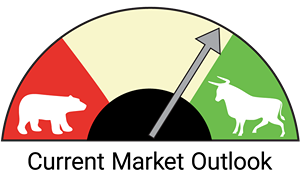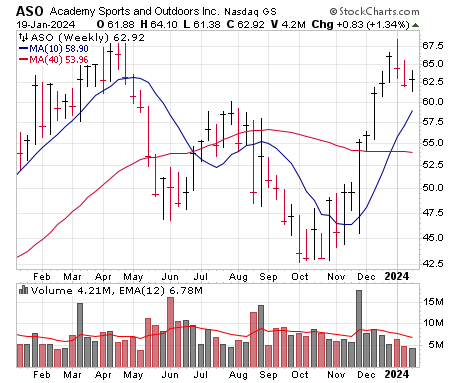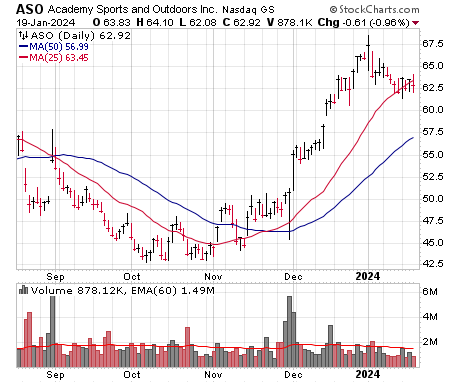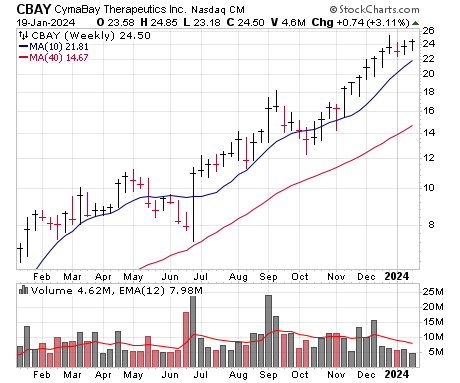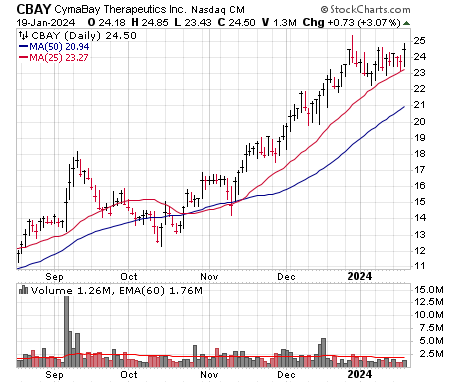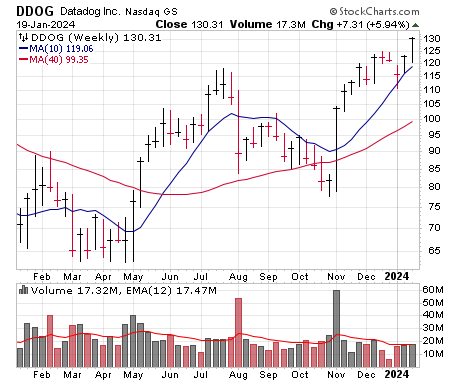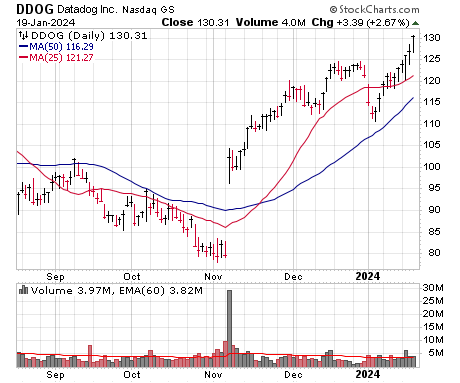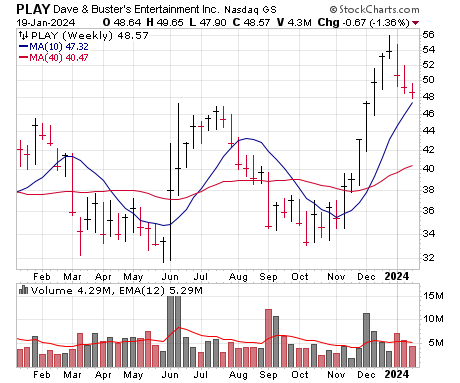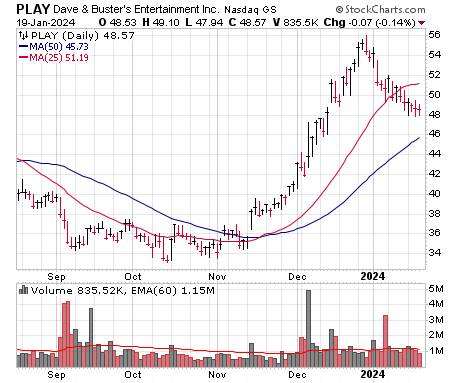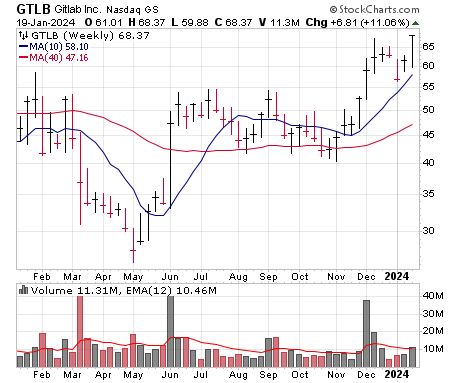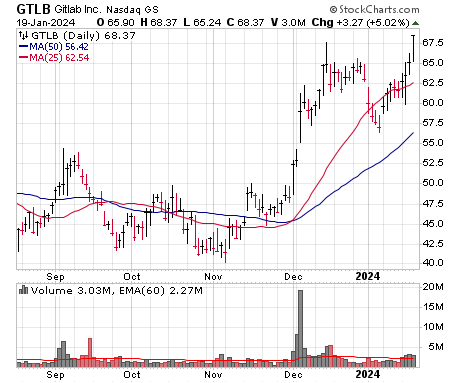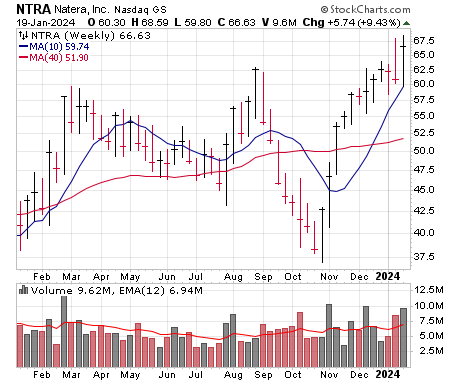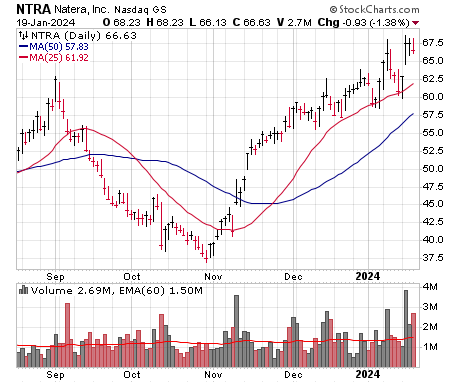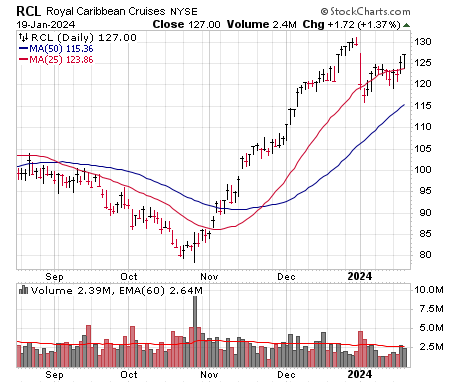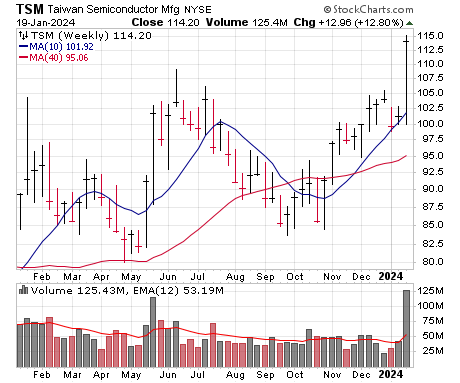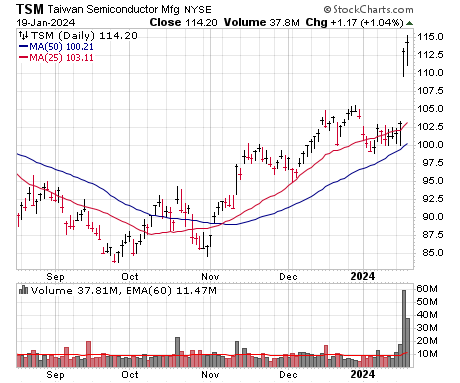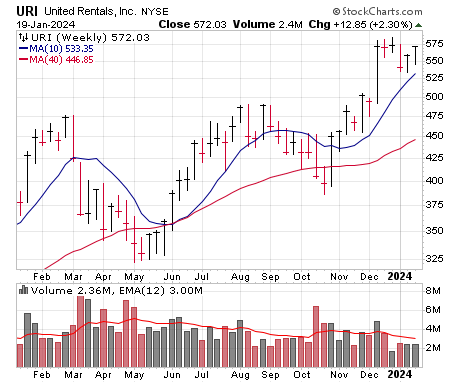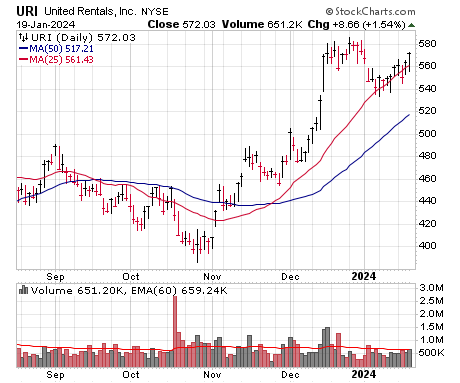Bulls in Charge (but Keep Your Feet on the Ground)
The vast majority of our work is based on the trends of the major indexes and the action of leading stocks, and on those two fronts, things look very good—some leaders have been tossed around in recent weeks, but the vast majority are in good shape, and there’s no question that the intermediate-term (and longer-term) trends of the market are pointed up. We’ve even seen the broad market perk up after a tough stretch, too, which helps the cause. About the only thing to worry about here is that ... there’s not much to worry about, and that many leading stocks are showing some near-term exhaustion patterns (many gaps up in a row, very extended to the upside, etc.). Big picture, we still think the odds favor us being early in a potential move, and we’re moving our Market Monitor back to a level 8, but you should still keep your feet on the ground, looking for decent entry points (preferably on dips) in strong stocks and having a fresh buy list as earnings season gets busier.
This week’s list has a lot of stocks that not only have excellent overall charts but have either consolidated calmly for the past few weeks—or have shown outstanding buying volume in recent days. Our Top Pick is Taiwan Semiconductor (TSM), which gapped up on earnings last week and should be starting a new run.
Price |
| Academy Sports & Outdoors (ASO) |
| Burlington Stores (BURL) |
| CymaBay Therapeutics (CBAY) |
| Datadog (DDOG) |
| Dave & Buster’s (PLAY) |
| GitLab (GTLB) |
| Natera (NTRA) |
| Royal Caribbean (RCL) |
| Taiwan Semiconductor (TSM) ★ Top Pick ★ |
| United Rentals (URI) |
Stock 1
Academy Sports & Outdoors (ASO)
Price |
Why the Strength
Academy Sports & Outdoors is an interesting situation: As its name suggests, the firm is one of the leading plays in the sports and outdoor equipment segment, bolstered by both a strong value proposition but also a wide assortment of both name brands and private-label offerings. All told, the firm has a slightly higher-income customer base than its peers, is gaining share and, impressively, has some of the best per-store metrics not just in the sporting group, but in retail as a whole in terms of sales ($24 million per store!) and EBITDA ($3.7 million); indeed, it says its least profitable stores are still as profitable as the average store of its competitors. And partially because of that, management isn’t resting on its laurels, aiming to be the big dog in the sector: Academy has 270 locations but that’s across only 18 states, so the company is set to expand that figure by 50% or so (about ~130 new locations) in just the next five years, and it already has three distribution facilities with plenty of spare capacity to support such growth. (Debt here is also very low, another plus as Academy embarks on an expansion phase.) The only issue here is lag effects from the pandemic—business went wild then due to cabin fever, but the post-pandemic sag is still cutting into sales (8% dip in same-store sales in Q3, though some of that was weather-related) and earnings. But most see that halting this year, with sales and earnings growth turning up, and longer term, management believes it can grow the top line to $10 billion by 2027 (up 60% from last year) as the store opening plan continues, with earnings and free cash flow doing even better (and leading to more share buybacks—share count was down 5% or so in the first three quarters of the year). A lot will depend on execution, but if things go according to plan, Academy Sports has great potential.
Technical Analysis
ASO looked very promising early last year, leaving behind a big post-IPO base and rallying nicely into the spring—until the wheels fell off, with the stock cascading a total of 38% (and falling back into its IPO structure) over the next six months. The comeback from there (helped by the market) was solid, with ASO getting to within spitting distance of its spring highs—and the three-week dip since then looks very tidy. We’re OK grabbing some shares here with a stop near the 50-day line.
| Market Cap | $4.67B | EPS $ Annual (Jan) | ||
| Forward P/E | 8 | FY 2022 | 7.60 | |
| Current P/E | 9 | FY 2023 | 7.71 | |
| Annual Revenue | $6.11B | FY 2024e | 7.08 | |
| Profit Margin | 9.7% | FY 2025e | 7.53 | |
| Qtrly Rev | Qtrly Rev Growth | Qtrly EPS | Qtrly EPS Growth | |
| ($B) | (vs. yr-ago-qtr) | ($) | (vs. yr-ago-qtr) | |
| Latest qtr | 1.40 | -6% | 1.38 | -17% |
| One qtr ago | 1.58 | -6% | 2.09 | -8% |
| Two qtrs ago | 1.38 | -6% | 1.30 | -24% |
| Three qtrs ago | 1.75 | -3% | 2.04 | 27% |
Weekly Chart | Daily Chart |
Stock 2
Burlington Stores (BURL)
Price |
Why the Strength
Burlington Stores is the third-largest off-price retailer in the U.S. after TJX and Ross Stores. Long known as Burlington Coat Factory, the business has moved well beyond just coats in recent years to offer a similar clothing and housewares mix that its larger competitors do. With more than 1,000 stores in 46 states and consistently profitable, it’s doing a good job. While it’s the price-value proposition that drives the business, Burlington is intensely focused on the idea of making their stores a pleasant place to shop, making sure products are organized and stores are neat. They also are increasingly giving employees mobile devices that can let them tell customers what’s in stock and where. The tech efforts are purely for in-store – interestingly, Burlington doesn’t have an e-commerce arm and has no plans to add one. Instead, its focus is on adding about 100 stores a year, net, after a big push to close older stores that have a square footage size that varied widely from what the company feels is its sweet spot (about 25,000 sf.). For the current quarter that ends January 31, management said in November it expected comp store sales to be even or even down 2% on increased shipping expenses and as inflation continues to hamper its lower-income customers. Burlington has been hurt by being overly optimistic on comp sales projections in prior years, so management has been upfront in saying they are being conservative now. They also note lots of signs their customers are now much more optimistic about their finances than they had been in 2022 and early 2023, so better times are likely ahead. After a big hiccup two years ago, last year’s bottom line likely lifted nicely and analysts see 2024 bringing another 25% gain as the turnaround continues.
Technical Analysis
BURL bottomed way back in September 2022 and had a nice rally after that—but it returned almost all the way to those lows last October, when shares dipped back to 115 or so. However, the late-November quarterly report looks like it finally kicked BURL out of its funk, with the stock gapping up in a big way and rallying all the way to near 200 at year’s end—and now shares have tightened up nicely for three weeks. If you want in, we’re OK taking a swing at it here.
| Market Cap | $12.6B | EPS $ Annual (Jan) | ||
| Forward P/E | 28 | FY 2022 | 8.41 | |
| Current P/E | 36 | FY 2023 | 4.26 | |
| Annual Revenue | $9.34B | FY 2024e | 5.63 | |
| Profit Margin | 3.7% | FY 2025e | 7.02 | |
| Qtrly Rev | Qtrly Rev Growth | Qtrly EPS | Qtrly EPS Growth | |
| ($B) | (vs. yr-ago-qtr) | ($) | (vs. yr-ago-qtr) | |
| Latest qtr | 2.29 | 12% | 0.98 | 128% |
| One qtr ago | 2.17 | 9% | 0.60 | 71% |
| Two qtrs ago | 2.14 | 11% | 0.84 | 56% |
| Three qtrs ago | 2.74 | 5% | 2.96 | 17% |
Weekly Chart | Daily Chart |
Stock 3
CymaBay Therapeutics (CBAY)
Price |
Why the Strength
California-based CymaBay develops therapies for patients with chronic diseases and high unmet medical needs. Its pipeline includes the lead drug candidate Seladelpar (MBX-8025), currently in a Phase III clinical trial for primary biliary cholangitis (PBC), a progressive inflammatory liver disease. The drug is also being tested for its ability to target a range of other diseases, including dyslipidemia, metabolic syndrome and even Type 2 diabetes. Additionally, CymaBay is developing another treatment, dubbed MBX-2982, for hypoglycemia in Type 1 diabetics (top-line Phase II results are expected out soon), and the firm has a worldwide license from Janssen Pharmaceuticals to develop drugs against an undisclosed metabolic disease target. Even so, Seladelpar is what CymaBay is hanging its hat on, and that drug has already received Breakthrough Therapy Designation from the U.S. FDA. The stock took flight in October after it became apparent that Seladelpar would gain the FDA designation for treatment of pruritus (itchiness) in adults without PBC, as the study met both its primary and secondary endpoints. The FDA ruling opens the door for the drug to receive final regulatory approval, and the company sees solid market potential once achieved; indeed, analysts estimate the PBC treatment market could reach $1.4 billion by 2032. CymaBay applied for a priority review of Seladelpar in December, which means a decision should be forthcoming by June (another reason for the strength). Like most clinical-stage companies, there’s not much to talk about on the financial front; however, CymaBay holds $439 million in cash, which it believes is sufficient to fund activities into 2026. Wall Street sees collaboration revenue picking up this year and expects the top line to boom starting in 2025, presumably when Seladelpar is commercialized.
Technical Analysis
CBAY is still a small-cap name (market cap south of $3 billion), but it’s put on a good show for many months, albeit with some dips along the way—the retreat last May and June found huge support near the 40-week line, while the pullback into October took the stock down 32% before the buyers swarmed. After running to 25, CBAY has tightened up near its 25-day line the past few weeks, though today’s move to new highs was rejected. Still, the overall pattern is fine, and we’ll set our buy range down from here, thinking some weakness could provide an opportunity to get in.
| Market Cap | $2.78B | EPS $ Annual (Dec) | ||
| Forward P/E | N/A | FY 2021 | -1.27 | |
| Current P/E | N/A | FY 2022 | -1.21 | |
| Annual Revenue | Nil | FY 2023e | -0.89 | |
| Profit Margin | N/A | FY 2024e | -1.44 | |
| Qtrly Rev | Qtrly Rev Growth | Qtrly EPS | Qtrly EPS Growth | |
| ($M) | (vs. yr-ago-qtr) | ($) | (vs. yr-ago-qtr) | |
| Latest qtr | N/M | N/M | -0.32 | N/A |
| One qtr ago | N/M | N/M | -0.01 | N/A |
| Two qtrs ago | N/M | N/M | -0.29 | N/A |
| Three qtrs ago | N/M | N/M | -0.30 | N/A |
Weekly Chart | Daily Chart |
Stock 4
Datadog (DDOG)
Price |
Why the Strength
Observability and security specialist Datadog is well known for its platform that enables clients to track the performance of all their apps. The focus on cloud infrastructure, network and server monitoring has served Datadog well, as it saw notable growth in enterprise customer growth and big-ticket ($100,000-plus) deals last year related to the never-ending cloud transformation. But the company is also poised to be a major player in the multi-trillion-dollar artificial intelligence transformation: A number of big-name consultancies have brought attention to Datadog’s leadership potential in AI used in the IT space due to the platform’s ability to offer “unparalleled data insights and visualizations,” in the words of one analyst. On that front, the company just announced a strategic partnership with Google Cloud customers to observe and secure their cloud-native and hybrid applications within Datadog’s unified platform, making Datadog the first AI observability partner for Google’s generative AI prototyping tool. It also allows AI ops teams and developers to monitor, analyze, and optimize the performance of their machine learning models in production. That should help down the road, but the main attractions right now are the still-strong top- and bottom-line beats and a sizable spike in big-ticket customer growth (up 20% year-on-year in Q3). Q3 revenue of $548 million increased 25%, while earnings of 45 cents topped estimates by 32%. This prompted several big Wall Street institutions to upgrade the shares, based partly on the thought that the cloud market has shown “meaningful improvement” in the last few quarters and the tech spending slowdown is coming to an end. Also, one bank noted that Datadog owns just a 12% share of the observability market, which is estimated to grow 11% annually in the coming years. Analysts see sales lifting in the low-20% range this year, which is likely conservative.
Technical Analysis
DDOG had a tough 34% retreat into the November market low, but the Q3 report changed the landscape (biggest weekly volume since 2020), leading to a huge gap and run to marginal new highs. There were some early-year wobbles, with DDOG dipping to the 10-week line, but the recovery from there has been solid, with the stock hitting fresh price and RP highs in recent days. We like the action, but don’t want to chase it here—we’ll set our buy range down a bit for new buyers.
| Market Cap | $42.8B | EPS $ Annual (Dec) | ||
| Forward P/E | 71 | FY 2021 | 0.48 | |
| Current P/E | 94 | FY 2022 | 0.98 | |
| Annual Revenue | $2.01B | FY 2023e | 1.53 | |
| Profit Margin | 29.3% | FY 2024e | 1.82 | |
| Qtrly Rev | Qtrly Rev Growth | Qtrly EPS | Qtrly EPS Growth | |
| ($M) | (vs. yr-ago-qtr) | ($) | (vs. yr-ago-qtr) | |
| Latest qtr | 548 | 25% | 0.45 | 96% |
| One qtr ago | 510 | 25% | 0.36 | 50% |
| Two qtrs ago | 482 | 33% | 0.28 | 17% |
| Three qtrs ago | 469 | 44% | 0.26 | 30% |
Weekly Chart | Daily Chart |
Stock 5
Dave & Buster’s (PLAY)
Price |
Why the Strength
Dave & Buster’s remains an intriguing turnaround-type situation, with a unique offering, a new management team, a bullish expansion plan and some eye-opening free cash flow that should keep investors interested—assuming the top brass pulls the right levers. The company has just over two hundred locations that combine bar/restaurant offerings with arcade/sports games and activities via both 159 namesake locations and, thanks to a 2022 acquisition, 58 Main Event locations (which skews a bit more toward families with kids) as well. In fact, the Main Event management team actually ended up taking over the entire operation once the buyout went through (they had a good track record growing Main Event’s business over time), and that seemed needed, as Dave & Buster’s growth fizzled once the post-pandemic rebound played out (organic revenue growth was flat the first three quarters of this year). But it seems like brighter times are ahead, with costs likely to be reeled in, with the store count expanding (likely to grow 15% total during the next couple of years and potentially more than doubling in the long term) and with better use of technology to target marketing and streamline operations. The result (at least according to management’s guesstimates at its Investor Day last June) is soaring EBITDA and free cash flow (possibly $1.7 billion worth of cumulative free cash flow during the next five years!) for many years, which it can use to further expand operations and to continue buying back a ton of shares (share count down 14% in Q3 compared to a year ago). Of course, that doesn’t mean the top line will go wild, but analysts see mid-single-digit sales growth this year while earnings gain more than 20% in 2024, both of which are likely conservative. The valuation (12x 2024 estimates) looks very reasonable, too.
Technical Analysis
PLAY bobbed and weaved between 30 and 50 for two and a half years, with multiple tests of both the top and bottom of the range during that time. The stock actually calmed down during September and October (good weekly price/volume action) and then took off on the upside, rallying seven weeks in a row and getting as high as 56 (PLAY’s highest level since mid-2019) in the process. Now we see yet another dip to the top-ish of the range, setting up an entry—if shares can rally further. We’ll set our buy range up from here, thinking a continued snapback will likely kick off a sustained upmove.
| Market Cap | $1.95B | EPS $ Annual (Jan) | ||
| Forward P/E | 11 | FY 2022 | 2.21 | |
| Current P/E | 17 | FY 2023 | 2.79 | |
| Annual Revenue | $2.17B | FY 2024e | 3.54 | |
| Profit Margin | 0.1% | FY 2025e | 4.28 | |
| Qtrly Rev | Qtrly Rev Growth | Qtrly EPS | Qtrly EPS Growth | |
| ($M) | (vs. yr-ago-qtr) | ($) | (vs. yr-ago-qtr) | |
| Latest qtr | 467 | -3% | 0.01 | -90% |
| One qtr ago | 542 | 16% | 0.60 | 2% |
| Two qtrs ago | 597 | 32% | 1.45 | 7% |
| Three qtrs ago | 564 | 64% | 0.80 | 54% |
Weekly Chart | Daily Chart |
Stock 6
GitLab (GTLB)
Price |
Why the Strength
One big theme we’re picking up on in a variety of technology sectors is the desire for big enterprises to consolidate their systems with platform providers, rather than manage a bunch of different point solutions by different firms. (One recent report said, in cybersecurity, enterprises often have up to 50 individual products they’re trying to manage and mesh together!) GitLab looks like a big (maybe the big) beneficiary of this when it comes to software development—the firm’s DevSecOps platform (stands for development, operations and security) makes it much more efficient for teams to plan, create, integrate, deploy, secure, monitor and improve its software production process (the firm claims a payback of just six months or so for many clients) and, with software a key for just about every large enterprise out there these days, the market is huge. Indeed, names like UBS, Nasdaq, Goldman Sachs, Lockheed Martin, T-Mobile, Ticketmaster, Suzuki, Nvidia and Airbus are all clients (all told, 50% of the Fortune 100 are signed up), and they’re buying more of GitLab’s offerings over time (same-customer revenue growth in the upper 20% range). And back to our original point, the firm thinks 84% of organizations use at least two (and up to 10) individual DevOps tools, and industry experts see 75% of firms switching to platforms by 2027 (up from 25% in 2023), leading to a massive opportunity for many years. GitLab’s growth slowed a bit along with the tech spending restraints in recent quarters, but revenue growth should remain rapid (30% or so) and earnings are beginning to take off, too. GitLab is a relatively new name that looks like a fresh leader.
Technical Analysis
GTLB’s massive upside reaction to earnings last June effectively marked the stock’s bottom, but it wasn’t ready to get going for another few months, with shares correcting and consolidating into the market low in early November. But then the character changed—GTLB rallied eight weeks in a row, including a monster-volume earnings reaction (nearly 10x volume on the gap, which historically is a tailwind), and after an early-year shakeout, has lifted to higher highs the past couple of days. Dips of a couple of points would be tempting.
| Market Cap | $9.22B | EPS $ Annual (Jan) | ||
| Forward P/E | 195 | FY 2022 | -0.66 | |
| Current P/E | 999 | FY 2023 | -0.46 | |
| Annual Revenue | $540M | FY 2024e | 0.13 | |
| Profit Margin | 11.0% | FY 2025e | 0.35 | |
| Qtrly Rev | Qtrly Rev Growth | Qtrly EPS | Qtrly EPS Growth | |
| ($M) | (vs. yr-ago-qtr) | ($) | (vs. yr-ago-qtr) | |
| Latest qtr | 150 | 32% | 0.09 | N/A |
| One qtr ago | 140 | 38% | 0.01 | N/A |
| Two qtrs ago | 127 | 45% | -0.06 | N/A |
| Three qtrs ago | 123 | 58% | -0.03 | N/A |
Weekly Chart | Daily Chart |
Stock 7
Natera (NTRA)
Price |
Why the Strength
Natera is the leader in cell-free DNA analysis, with the largest market share when it comes to screening tests for prenatal, oncology and organ health. Natera uses cell-free DNA (cfDNA) fragments in the bloodstream as its source material, allowing it to detect disease in a non-invasive manner, which contrasts with traditional methods. The company established itself with Panorama, a test that uses the mother’s blood to detect a variety of fetal ailments. Panorama holds a 50% (and growing) market share in prenatal testing, with most testing in California recently shifting to Natera from a competitor. The company periodically improves the test, so even though Panorama has been around since 2013, it’s on its seventh generation, staying ahead of competitors. The business is also seeing a lot of strength in a test it rolled out in 2019, Signatera, which uses cfDNA to screen for colorectal cancer and claims about one-third of oncologists in the U.S. as clients. In recent months, the test has benefited from widespread approval for detecting solid-tumor breast cancer—last year Medicare elected to cover Signatera as a breast cancer screen, a significant decision since Medicare coverage already accounts for the majority of annual revenue. A similar test called Prospera screens for kidney, heart and lung diseases and is seeing high rates of uptake by physicians around the country. As for the stock’s latest pop, that was thanks to the courtroom, where a patent battle essentially ended in the firm’s favor, reinforcing the view that Natera’s patent portfolio is rock solid. The firm pre-announced a great Q4 earlier this month (revenues up 38%), and analysts see the top line lifting 21% in 2024 (likely conservative)—all while the firm should reach cash flow breakeven this year.
Technical Analysis
NTRA looked ready to get going twice last year, once in March (when the stock rounded out a big base) and again in September (when shares briefly moved to new highs), both times seeing the 60 area reject the stock and (after the latter case) leading to a big dip. But NTRA has been acting great since the November market low, getting back to that 60 level and holding its 25-day line—with last week’s court-induced pop a good sign. We’ll set our buy range down a bit, but the odds favor the uptrend continuing.
| Market Cap | $8.01B | EPS $ Annual (Sep) | ||
| Forward P/E | N/A | FY 2021 | -5.21 | |
| Current P/E | N/A | FY 2022 | -5.57 | |
| Annual Revenue | $988M | FY 2023e | -3.83 | |
| Profit Margin | N/A | FY 2024e | -2.61 | |
| Qtrly Rev | Qtrly Rev Growth | Qtrly EPS | Qtrly EPS Growth | |
| ($M) | (vs. yr-ago-qtr) | ($) | (vs. yr-ago-qtr) | |
| Latest qtr | 268 | 27% | -0.95 | N/A |
| One qtr ago | 261 | 32% | -0.97 | N/A |
| Two qtrs ago | 242 | 25% | -1.23 | N/A |
| Three qtrs ago | 217 | 26% | -1.37 | N/A |
Weekly Chart | Daily Chart |
Stock 8
Royal Caribbean (RCL)
Price |
Why the Strength
“Cruising is back!” That’s the consensus of industry experts after last year’s “revenge travel” trend that saw a massive return of cruise ship bookings. Among the big industry players to stage a comeback from years of Covid-era travel restrictions, Royal Caribbean (covered in the November 20 report) has finally returned to a pre-pandemic level of strength. The company, of course, is one of the world’s largest cruise lines by annual revenue, with 64 ships and more than 1,000 destinations, and it reported that bookings “significantly” exceeded 2019 levels in its latest quarter. The company further said bookings for 2024 remain strong and have “consistently” outpaced those levels, indicating that it continues to sell more tickets at higher rates than ever before while its booking window keeps extending out into the future. In Q3, total revenue exceeded 2019 levels by more than 30%, hitting a record-breaking $4.2 billion. What’s more, the company’s newest ship, Icon of the Seas—billed as the world’s largest—is set for its inaugural voyage later this month. The 1,200-foot Icon has an eye-popping capacity of over 5,600 passengers and is expected to boost Q1 revenue for the company by 5%. Another new vessel, Celebrity Ascent, is touted as one of Royal’s most innovative ships, featuring 32 restaurants, bars and lounges—it was just launched and will serve Caribbean and Mediterranean sailings this year. All told, the upbeat outlook for the new year has prompted a number of Wall Street firms to upgrade shares, including a big investment bank that named Royal as one of its top growth stocks for a falling interest rate environment (a reason for the stock’s strength). When Q4 earnings are released February 1, analysts expect a 29% year-on-year sales boost, and management still sees north of $10 in EPS by 2025 (which is looking conservative given the $9-plus estimates for this year).
Technical Analysis
After a strong breakout last May on earnings, RCL soared by over 50 points before hitting a wall in July at 113. The market pulled shares back to earth from there before the 40-week line—and the Q3 report—came to the rescue in October. Shares rode the ensuing wave of buying into late December before finally hitting a turn-of-the-year pothole, with sellers taking a quick 15 points out of the stock. Still, RCL never cracked any support, and now it’s nosing its way higher. The path of least resistance remains up, though near term, dips of a few points would provide a better entry.
| Market Cap | $32.5B | EPS $ Annual (Dec) | ||
| Forward P/E | 14 | FY 2021 | -19.19 | |
| Current P/E | 29 | FY 2022 | -7.50 | |
| Annual Revenue | $13.2B | FY 2023e | 6.63 | |
| Profit Margin | 25.6% | FY 2024e | 9.18 | |
| Qtrly Rev | Qtrly Rev Growth | Qtrly EPS | Qtrly EPS Growth | |
| ($B) | (vs. yr-ago-qtr) | ($) | (vs. yr-ago-qtr) | |
| Latest qtr | 4.16 | 39% | 3.85 | N/A |
| One qtr ago | 3.52 | 61% | 1.82 | N/A |
| Two qtrs ago | 2.89 | 172% | -0.23 | N/A |
| Three qtrs ago | 2.60 | 165% | -1.12 | N/A |
Weekly Chart | Daily Chart |
Stock 9
Taiwan Semiconductor (TSM) ★ Top Pick ★
Price |
Why the Strength
After a multi-quarter slump, the semiconductor space is poised to bounce back strongly in 2024, with all signs pointing to a renewed chip spending cycle across several key industries. Taiwan Semiconductor is the world’s largest dedicated pure-play semiconductor foundry, and its chips are widely used in devices made by Tesla, Nvidia, Apple and other giants. The company had what it described as a “challenging” 2023 due to industry-related setbacks and a slowdown in smartphone demand, but management is predicting stronger growth rates in 2024, supported by a ramp of its industry-leading three- and five-nanometer technologies and “robust” artificial intelligence demand. Last week, Taiwan Semi reported Q4 revenue of $20 billion that was essentially flat compared to a year ago, but it beat estimates by 3% and was 14% higher from Q3. Earnings of $1.50 beat estimates by eight cents and were 19% higher sequentially (both reasons for the stock’s strength). By segment, three-nanometer process technology contributed 15% of wafer revenue in Q4, while five-nanometer and seven-nanometer accounted for 35% and 17%, respectively; thus, Advanced Technologies (defined as seven-nanometer and below) accounted for 67% of wafer revenue. The biggest reason for the stock’s strength, though, was the outlook—the top brass said the slowdown was over and that revenue should grow by around 20% annually for the next few years, prompting several Wall Street institutions to increase price targets for Taiwan Semi. The expansion is expected to result from soaring demand for AI chips, with generative AI likely to provide a long-term growth runway in the coming decade (indeed, the market opportunity for GenAI hardware is projected to rise at a torrid 33% annual growth rate). Analysts see 20%-ish top- and bottom-line growth for 2024 and 2025, and many think even that will prove low as the next chip upcycle gets going.
Technical Analysis
Despite an industry-wide slump in 2023, TSM bottomed in 2022 and managed a solid rally into June, rallying up to 110 on hopes for an industry turnaround. Perception waned with the market in the summer and fall, but the stock used that time to build a great-looking launching pad, with many weeks of accumulation (up on above-average weekly volume) and some tight trading, too. And now we have the breakout, with TSM soaring last Thursday and Friday on huge volume to two-year highs. We think TSM is headed higher—you can enter here.
| Market Cap | $592B | EPS $ Annual (Dec) | ||
| Forward P/E | 18 | FY 2022 | 6.39 | |
| Current P/E | 22 | FY 2023 | 5.27 | |
| Annual Revenue | $69.4B | FY 2024e | 6.27 | |
| Profit Margin | 44.3% | FY 2025e | 7.90 | |
| Qtrly Rev | Qtrly Rev Growth | Qtrly EPS | Qtrly EPS Growth | |
| ($B) | (vs. yr-ago-qtr) | ($) | (vs. yr-ago-qtr) | |
| Latest qtr | 20.4 | 0% | 1.50 | -19% |
| One qtr ago | 16.9 | -12% | 1.26 | -26% |
| Two qtrs ago | 15.4 | -14% | 1.13 | -27% |
| Three qtrs ago | 16.70 | -3% | 1.31 | -4% |
Weekly Chart | Daily Chart |
Stock 10
United Rentals (URI)
Price |
Why the Strength
Construction spending for manufacturing facilities in the U.S. hit a record in 2023 and was up a staggering 130% during the first nine months alone compared to pre-pandemic 2019. Among last year’s major projects were Texas Instruments’ $11 billion semiconductor plant in Utah, LG Energy’s $5.5 billion investment in an Arizona electronic vehicle (EV) battery complex and a $500 million investment by Siemens across several U.S. states (ranging from datacenter equipment to rail cars and locomotives). While there were plenty of industries in this boom, semiconductors and EV battery makers consistently ranked among the biggest projects. United Rentals (covered in the December 4 issue) is the market share leader in North American equipment rentals with a $20 billion fleet consisting of around 4,600 equipment classes used for industrial and non-residential construction, and it continues to benefit from the factory building boom. The latter market was a prime contributor to the company’s stellar Q3 results, which included a 23% year-on-year sales increase of nearly $4 billion, estimate-beating EPS of $11.73 and free cash flow that nearly doubled in the quarter. Non-residential construction grew 9% in Q3 as its customers kicked off new projects across the board, including several EV- and semiconductor-related jobs, infrastructure projects, data centers, healthcare and solar power facilities. On the residential side, homebuilders remain in fine shape heading into the new year, as a nationwide housing shortage is providing a sizable runway for construction firms to fill the demand gap. Just as important is the future, with the dip in interest rates and the Fed likely turning from foe to friend implying business should remain strong. A modest valuation helps the cause.
Technical Analysis
URI actually hit a new high in early 2023, but that move proved false, leading to another huge consolidation that took the stock down 33% in the spring and (after a rally back) 21% in the fall. However, the Q3 report got the stock moving, and the breakout came in December as the Fed indicated it was done hiking. The recent dip to the 25-day line was normal, and now URI is marching back toward its highs—we’re OK grabbing some on a bit of an exhale.
| Market Cap | $38.8B | EPS $ Annual (Dec) | ||
| Forward P/E | 13 | FY 2021 | 22.06 | |
| Current P/E | 14 | FY 2022 | 32.49 | |
| Annual Revenue | $13.9B | FY 2023e | 40.20 | |
| Profit Margin | 27.8% | FY 2024e | 42.83 | |
| Qtrly Rev | Qtrly Rev Growth | Qtrly EPS | Qtrly EPS Growth | |
| ($B) | (vs. yr-ago-qtr) | ($) | (vs. yr-ago-qtr) | |
| Latest qtr | 3.77 | 23% | 11.73 | 27% |
| One qtr ago | 3.55 | 28% | 9.88 | 26% |
| Two qtrs ago | 3.29 | 30% | 7.95 | 39% |
| Three qtrs ago | 3.30 | 19% | 9.74 | 32% |
Weekly Chart | Daily Chart |
Previously Recommended Stocks
| Date | Stock | Symbol | Top Pick | Original Buy Range | 1/22/24 |
| HOLD | |||||
| 12/18/23 | 133-137 | 168 | |||
| 1/8/24 | 42.5-46 | 44 | |||
| 1/2/24 | 41-43 | 43 | |||
| 1/8/24 | 128-133 | 134 | |||
| 1/16/24 | 229-235 | 246 | |||
| 1/16/24 | 47-48.5 | 46 | |||
| 9/5/23 | ★ | 161-166 | 299 | ||
| 12/18/23 | 120-124 | 133 | |||
| 12/11/23 | ★ | 45.5-48 | 51 | ||
| 1/8/24 | 690-700 | 768 | |||
| 11/6/23 | 86.5-89 | 105 | |||
| 11/6/23 | ★ | 33-35 | 38 | ||
| 12/4/23 | 106-112 | 123 | |||
| 1/16/24 | 22-22.7 | 23 | |||
| 1/2/24 | 82.5-85.5 | 87 | |||
| 1/2/23 | 20-21 | 19 | |||
| 12/11/23 | 58-60.5 | 70 | |||
| 1/16/24 | ★ | 86-89 | 93 | ||
| 1/16/24 | 102-105 | 108 | |||
| 1/8/24 | 179-183 | 188 | |||
| 1/2/24 | 67.5-69.5 | 67 | |||
| 1/8/24 | 80-83 | 84 | |||
| 1/8/24 | 146-150 | 155 | |||
| 11/6/23 | 433-445 | 508 | |||
| 1/2/24 | ★ | 127-132 | 140 | ||
| 1/8/24 | 104-107 | 105 | |||
| 9/5/23 | ★ | 33-34.5 | 56 | ||
| 2/27/23 | 225-230 | 597 | |||
| 11/6/23 | 29.5-31 | 37 | |||
| 11/20/23 | ★ | 86.5-89 | 109 | ||
| 11/20/23 | 101-104 | 127 | |||
| 1/2/24 | 702-712 | 752 | |||
| 1/16/24 | 77-80 | 80 | |||
| 1/8/24 | ★ | 16.5-17.5 | 17 | ||
| 10/30/23 | 166-169 | 206 | |||
| 11/6/23 | 77-79 | 103 | |||
| 1/16/24 | 357-367 | 383 | |||
| 1/16/24 | 77-80 | 88 | |||
| 1/8/24 | 20.5-21.5 | 21 | |||
| 5/8/23 | 37-39 | 65 | |||
| 12/4/23 | 505-515 | 579 | |||
| 12/4/23 | Vertiv Holdings | VRT | ★ | 44-46 | 53 |
| WAIT | |||||
| 1/16/24 | Intuitive Surgical | ISRG | 345-355 | 376 | |
| SELL | |||||
| 12/18/23 | 47-49 | 48 | |||
| 11/13/23 | 202-208 | 197 | |||
| 1/2/24 | 21.4-22.4 | 22 | |||
| 1/2/24 | 80.5-82.5 | 89 | |||
| 12/11/23 | 187-191 | 199 | |||
| 12/4/23 | Workday | WDAY | 257-264 | 290 | |
| DROPPED | |||||
The next Cabot Top Ten Trader issue will be published on January 29, 2024.
